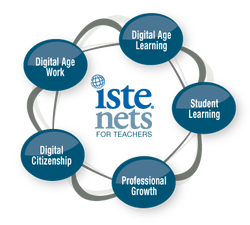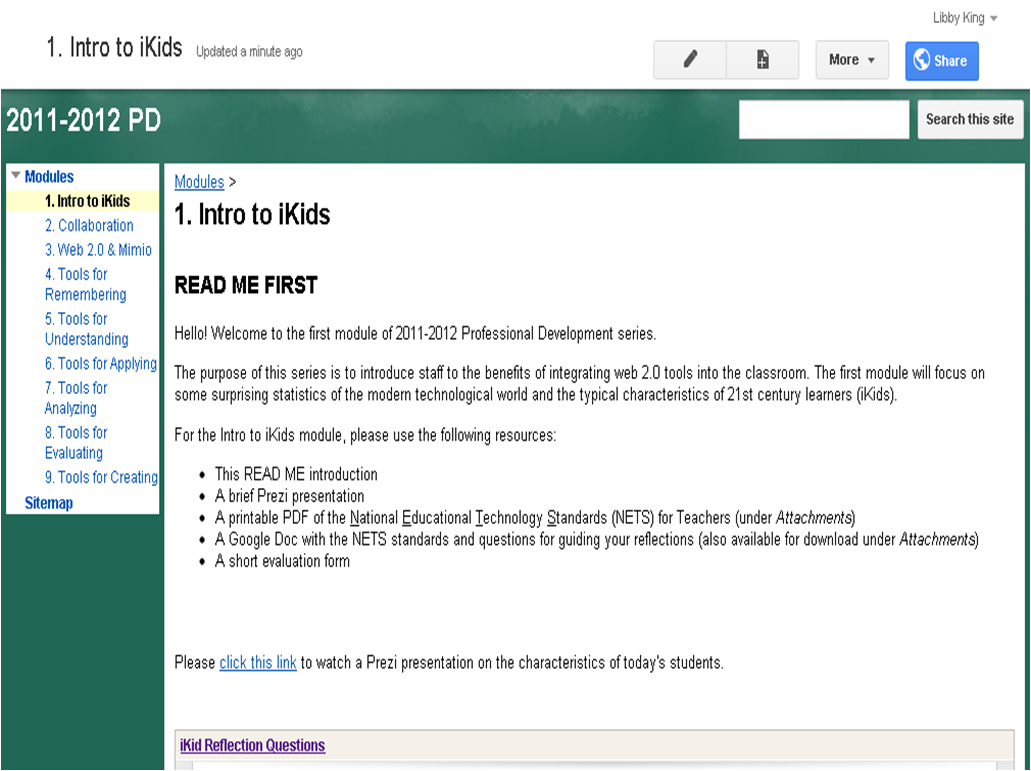5. Engage in Professional Growth and Leadership

Teachers continuously improve their professional practice, model lifelong learning, and exhibit leadership in their school and professional community by promoting and demonstrating the effective use of digital tools and resources.
a. Participate in local and global learning communities to explore creative applications of technology to
improve student learning
b. Exhibit leadership by demonstrating a vision of technology infusion, participating in shared decision making and community building, and developing the leadership and technology skills of others
c. Evaluate and reflect on current research and professional practice on a regular basis to make effective use of existing and emerging digital tools and resources in support of student learning
d. Contribute to the effectiveness, vitality, and selfrenewal of the teaching profession and of their school and community
a. Participate in local and global learning communities to explore creative applications of technology to
improve student learning
b. Exhibit leadership by demonstrating a vision of technology infusion, participating in shared decision making and community building, and developing the leadership and technology skills of others
c. Evaluate and reflect on current research and professional practice on a regular basis to make effective use of existing and emerging digital tools and resources in support of student learning
d. Contribute to the effectiveness, vitality, and selfrenewal of the teaching profession and of their school and community
Artifact 1: Research Paper on the Flipped Classroom
|
|
This artifact is a research paper I completed looking at the history, process, benefits, and criticisms of the new trend of flipped classrooms. In brief, the flipped classroom is about using digital media (videos, podcasts, PowerPoints on the internet) to allow students to access lecture material at home for homework, therefore reserving class time for more hands-on activities, including – but not limited to – working through homework problems, just-in-time teaching, and peer instruction. Although not included on this webpage, I also created a PowerPoint on this topic and presented it to the professor and a small group of classmates.
|
Artifact 2: Year long Professional Development Plan
|
This Google site is an outline and first lesson of a year-long professional development series on integrating web 2.0 tools into the classroom. The first module delves into the characteristics of the typical iKid (21st century learners), asks teachers to reflect on what they learned, and solicits feedback on how to improve the series. While the other modules did not have to be fleshed out per the requirements of the assignments, I appreciated the experience of designing and developing an extended professional development plan. Also, this was the first time I created my own Google site, a great tool for collaborating.
|
Reflections
As stated in before, technology professional development is my passion, so this standard is very important to me. Technology changes at such a rapid rate that it is imperative that educators engage in professional development on a continual basis. Thankfully, with the advent of so many communities and collaborative activities on the internet, professional development no longer has to involve sitting in on a lecture for long periods of time; professional development can occur in small doses, delivered in a timelier manner, with a much higher degree of personalization than ever before.
Both of these artifacts support my dedication to this standard. With my paper on the flipped classroom, I joined several online communities related to this topic to better understand the act of flipping and the effects on students and teachers. I also read a variety of sources so I could best “[e]valuate and reflect on [the] current research” on this emerging practice. My year long professional development plan was created so that I could “develop[] the leadership and technology skills” of my coworkers, and therefore play my part in “[contributing] to the effectiveness, vitality, and selfrenewal of the teaching profession.” I am particularly proud of the professional development plan as it practices what I preach and makes use of current technology tools and trends. Too often technology professional development relies on outdated technology that in no way reflects the message of the instruction. If technology integrationists want to encourage educators to use collaborative tools like wikis they themselves should be using wikis.
Both of these artifacts support my dedication to this standard. With my paper on the flipped classroom, I joined several online communities related to this topic to better understand the act of flipping and the effects on students and teachers. I also read a variety of sources so I could best “[e]valuate and reflect on [the] current research” on this emerging practice. My year long professional development plan was created so that I could “develop[] the leadership and technology skills” of my coworkers, and therefore play my part in “[contributing] to the effectiveness, vitality, and selfrenewal of the teaching profession.” I am particularly proud of the professional development plan as it practices what I preach and makes use of current technology tools and trends. Too often technology professional development relies on outdated technology that in no way reflects the message of the instruction. If technology integrationists want to encourage educators to use collaborative tools like wikis they themselves should be using wikis.

